 News
News
 News
News
 News
News
 News
News
Submitted – January 2022
The tradition of winter carnivals in New Hampshire started at Dartmouth College in 1911. “ The town of Newport jumped on board with a winter carnival“ in 1916.“ Hillsborough joined the emerging tradition in 1925 after the Hillsborough Messenger, in a January 8 front page editorial, asked: “Why not winter sports in Hillsboro?”“ Members of the Hillsborough Center Club stepped forward and organized an event involving ski racing, snowshoe baseball, a baked bean supper and a carnival ball.“ A winter festival, held in January or February, was held periodically through the late 1920’s into the 1930’s.“ World War II and postwar economic instability disrupted the tradition until winter carnivals re-emerged in the mid-1950’s.“ After another break in the tradition during much of the 1960’s, Hillsboro-Deering High School stepped in during the 1970’s to keep the winter carnival torch alive and the Hillsboro chapter of the Jaycees briefly joined the effort in the late 1970’s.
Hillsborough’s early winter carnivals combined outdoor winter sporting activities with evening entertainments centered around a carnival ball.“ In addition to skiing, skating, tobogganing and dog sledding, winter carnivals offered horse racing, snowshoeing, basketball, baseball, and airplane rides taking off from Pierce Lake.“ A grand parade down Main Street consisting of floats and sleighs drawn by one- and two-horse hitches took place in 1929.“ A noteworthy exception to the parade guidelines was Deering’s E.P. Dutton’s 10 yoke of oxen. “ In the winter of 1930-31, the Boston and Maine Railroad began to run highly successful “snow trains” to New Hampshire, which increased outdoor recreation state-wide.“ In 1932, a “snow train” brought 1,200 “winter sports enthusiasts” from Boston, Worcester, Manchester and Concord to Hillsborough’s day-long winter carnival.“ The late 1950’s saw snow sculptures and chainsaw wood cutting contests in Butler Park.“ In 1968, an event involving 52 snow machines competing in races drew a crowd of 800 to the fields west of town,“ across from today’s“ Osram/Sylvania plant.
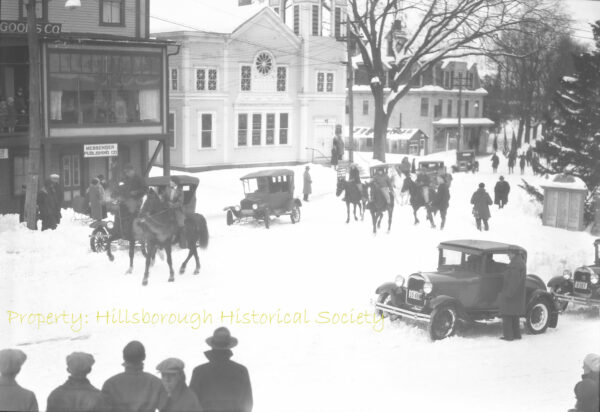
A variety of locations in Hillsborough and Deering have been settings for the outdoor events.“ Hillsborough Center hosted the first two winter carnivals, while Grimes Field and Pierce Lake anchored events in the late 1920’s and early 1930’s.“ The February 23,1933, edition of The Hillsboro Messenger observed that Pierce Lake and its surrounding hills were perhaps the most “natural and beautiful spot in New England for a winter carnival” and suggested that the area be developed into a regional winter sports destination.“ Enameled metal signs were produced promoting Hillsborough along with“ nearby Washington and Deering as “The Switzerland of New England.”“ This vision of a winter sport snow-bowl in the hills around Pierce Lake did not materialize but the Carew family did build a ski tow in Deering Center in the late 1940’s.“ The Deering ski tow hosted competitive high school ski races as part of the winter carnivals of the 1950’s.“ Dog sled teams, always a highlight of winter carnivals, competed on a 13.2-mile course through Hillsborough and Deering.“ Twenty-two teams competed in races organized by the New England Sled Dog Race Association in 1957.“ A year later, over 1,000 spectators turned out to watch 19 teams compete over two days.
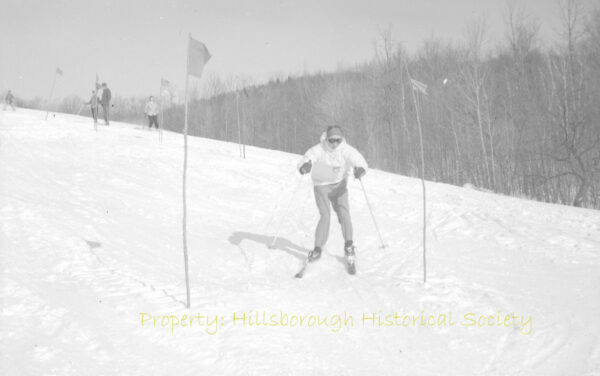
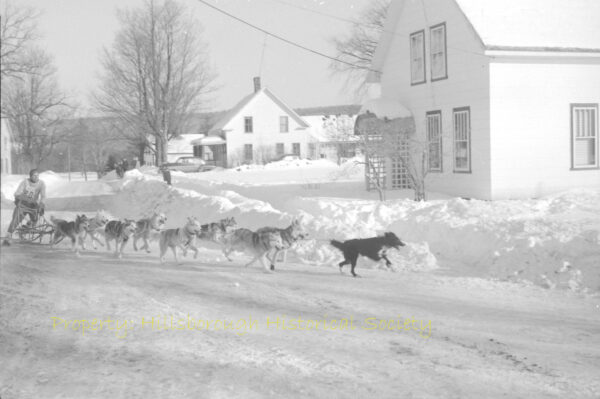
The success of the annual winter carnival has depended on the energy and commitment of town organizers and, of course, the cooperation of an unpredictable mother nature.“ Mabel Gay mobilized the efforts of the Hillsboro Center Club during the 1920’s. The Hillsboro Business Association, led by Phillip Woodbury, George Gould, Frank Gay and William Niedner,“ spearheaded efforts during the late 1920’s and early 30’s.“ A Recreation Council took charge in the 1950’s to oversee an expanded three-day event with Harold Byam, Harvey Chandler and Dave Smith chairing the carnival committee at various times.“ The Hillsborough business community and individual donors provided funding.“ In the 1950’s local businesses stepped forward to sponsor one or more of the 20 plus dog sled teams that competed in the New England Sled Dog races.“ In the late 1970’s, Hillsborough’s Jaycees, led by Mike Marguiles and Leigh Bosse, organized a town-wide “WinterThing” celebration.“ Students and staff in the Hillsboro-Deering schools have continued the tradition of the annual winter carnival since the 1970’s.
The indoor activities held on Friday and Saturday evenings included one-act plays, high school basketball games and the highlight of the weekend, the carnival ball and the crowning of the carnival ball queen.“ In 1929 events were held at the Hillsborough Opera House.“ That year, the Hillsboro Dramatic Club put on a one act play/farce, “The Hickville Bungler.”“ During the 1950’s, a drum and bugle corps performance, square dancing, round dancing and Sunday church services were added to the program.“ The carnival ball and crowning of the ball queen took place throughout the history of Hillsborough’s winter carnival.“ Mrs. George F. Gould was crowned Carnival Queen in 1925.“ Doris Radford took the honor in 1929, while Henniker’s Judy Ward was Carnival Queen in 1958.
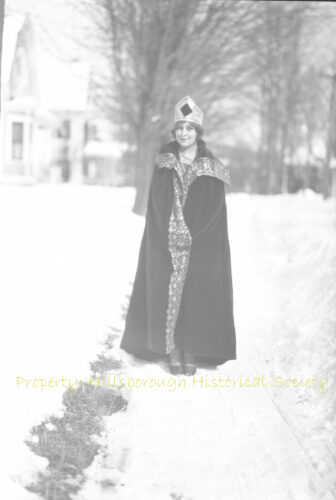
As mentioned, another break in the winter carnival tradition appears to have occurred in the 1960’s.“ The Recreation Council disbanded in 1960.“ Ideal weather conditions, always hit or miss, were mostly a miss in 1959 and again in 1960.“ In fact, the lack of snow in 1960 led to the last-minute cancellation of the New England Sled Dog races.“ The winter carnival torch was then picked up and kept alive by Hillsboro-Deering students and staff.“ Hillsboro-Deering High School’s 1974 winter carnival was over a week long. “ When mother nature failed to deliver adequate snow, the Hillsboro Public Works Department stepped in to haul snow to ensure that skiing and snow sculpture contests took place as planned.“ Other activities included class skits, basketball games, a carnival dance and carnival queen, poetry, poster and photography contests as well as broom hockey on the Grimes Field ice rink.“ The Jaycees’ “WinterThing” in 1978 briefly resurrected the multi-event, multi-day town-wide winter carnival.“ Over the course of ten days in late January residents and guests competed in cross country snow mobile races, as well as card games and bingo.“ Hillsboro once again hosted New England sled dog races.“ There was a bonfire/skating party and a ham & bean supper.“ Mother nature did not disappoint.“ A young folks’ winter Olympics, originally scheduled for Saturday, January 21, was postponed due to heavy snowfall the day before.“ While organizers had the skiing venue ready to go on the 21st many of the competitors could not make it to the event.“ A successful winter Olympics took place on February 12.
Hillsborough can take great pride in the success of its winter carnivals.“ Visitors from throughout New England have journeyed to Hillsborough to compete in a variety of events and to enjoy the area’s natural winter beauty.“ More importantly, Hillsborough residents of all ages have joined in the community wide effort.“ The town’s business community, schools, civic organizations and ad hoc committees have come together to host multi-event and multi-day winter celebrations.“ This spirit of civic engagement continued into the late 20tth and early 21st centuries through the Hillsborough Balloon Festival, Summerfest, the Schnitzel Festival and History Alive celebrations.“ It continues today as Hillsborough celebrates its 250th anniversary.
Sources:
This overview of Hillsboro’s winter carnival tradition is mostly drawn from numerous articles from the Hillsboro Messenger archives available online through Hillsborough’s Fuller Public Library.
Baldwin, Harrison C “ The History of Hillsborough New Hampshire: 1921 to 1963“ Transcript Printing Co.,
Peterborough, NH“ c. 1964
Federal Writers’ Project of the Works Progress Administration, New Hampshire: A Guide To The“
Granite State,“ Boston: Houghton Mifflin Co., c. 1938, p. 524.
Hillsboro Messenger“ 1/8/1925, 1/22/25, 2/12/25, 2/26/25, 2/18/26, 225/26, 1/10/1929, 1/31/29, 2/6/29, 2/14/29, 2/21/29, 2/28/29, 2/20/30, 2/27/30, 3/3/32, 2/16/33.2/23/33, 1/14/60, 1/24/57, 1/18/58, 1/23/58, 2/15/1968, 2/22/68, 2/20/74, 1/11/78, 1/18/78
Hillsborough Town Reports, 1954 to 1959.
 News
News
Submitted – September 2021
On Wednesday, February 24, 12-year-old Hendrick Jordan and 11-year-old Antres Onnela drowned in the Contoocook River upstream from“ Bridge Street while skating on the recently frozen river.“ It was school vacation week and the boys had headed off to go skating around 9:30 a.m.“ Antres’ father, who had warned them against skating on the river, went to look for the boys when they failed to return to the Onnela family home near Grimes Hill.“ He found their shoes on the river bank, skate marks on the ice, and a hole in the ice where the boys had fallen in.“ An intense multi-day search followed led by Police Chief Frank Paige and involved frantic family members, Hillsborough residents (including all three selectmen), and eventually, a professional diver from Somerville, Massachusetts.“ The boys’ fathers and volunteers searched all night Wednesday and into Thursday when temperatures approached 0 degrees Fahrenheit.“ The diver, Fred Wallace, located Hendrick’s body around midday on Friday, February 26, near where the boys had fallen in.“ The search for Antres continued Friday afternoon and into Saturday.“ His body was recovered late in the day on Saturday, about 200 feet downriver.“ “
While this tragedy was unfolding, the grief-stricken town prepared for the arrival of a “snow train” carrying 1,200 “winter sports enthusiasts” for a snow carnival to be held on Sunday, February 28.“ The Boston and Maine Railroad had recently been marketing Sunday snow train excursions to various locations in New Hampshire, including Crawford and Pinkham Notches, Warner and Jaffrey.“ After consulting “reports furnished by expert observers” associated with the Appalachian Mountain Club’s Ski Committee, the company would announce the snow train’s destination on Boston radio stations (WEEI) and in Boston newspapers on Fridays and Saturdays. “ Snow trains would leave Boston and Worcester early Sunday morning bound for New Hampshire, described as the “Switzerland of New England.”“ In addition to passenger cars, the trains included supply cars stocked with equipment for purchase or rent and dining cars. Round trip tickets cost $1.75 to $2.75, depending upon the destination.“ Lunch could be had for .65 cents and dinner for .90 cents.“ William Niedner, Philip Woodbury, and other members of the Hillsborough Business Association had been working since early January to arrange a snow train to Hillsborough.“ A meeting had been held to gauge local support for hosting a snow train. “ Niedner (who owned Rosewald Farm) had even traveled to B & M offices in Boston to advocate for Hillsborough.“ Committees had been meeting to address transportation, hospitality, and publicity needs. It appears that word reached Hillsborough sometime on Friday that the town was the destination for a snow train on Sunday, February 28.“ At that point, the search for the boys was ongoing and there apparently wasn’t time to alter Sunday’s plans.“ The snow train arrived Sunday morning at Hillsborough Depot greeted by the Hillsborough Band playing “Hail, Hail the Gang’s All Here.” “ Local residents were on hand in cars and trucks to transport guests to various winter sporting sites around town.“ Visitors from near and far arrived to participate in skiing, skating, snowshoeing, tobogganing, and dog sledding.“ The Jackman Reservoir (Pierce Lake) below Gibson Mountain was an especially active site where, in addition to skating, skiing, and dog sledding, folks could get a ride in Stewart Astles’ airplane.“ The Rosewald Farm and Parker Hill were also busy venues as was a site in Deering.“ Dining services were available at the Hillsborough Community Hall and on B & M RR dining cars. Local boys helped guide guests to and around the sites.“
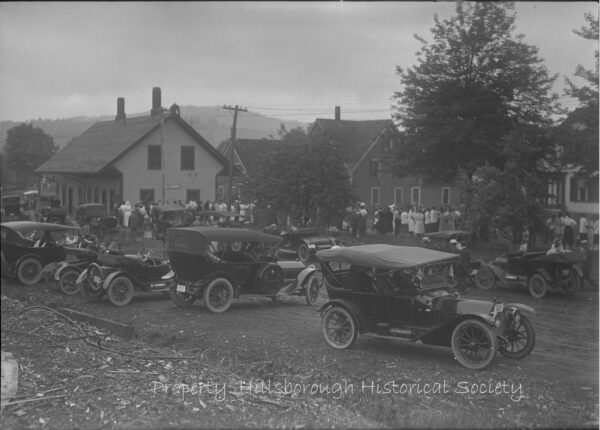
The snow train departed Hillsborough on its return trip late in the day on Sunday.“ Funerals for the two boys were held the next day from their homes. The service for Antres Onnela started at 1 pm and was led by Rev. Frank Coad of Smith Memorial Church.“ Classmates who served as his funeral bearers were Norman Coad, James Stafford, Harold Travers, Earl Boutelle, Leo Laflamme, and Frank Camara. “ One hour later, Rev. H.H. Crawford of the Deering Community Church led the service for Hendrick. “ George Colby, Donald Mellen, Albert Mosley, George Barrett, Norman Crooker, and Harold Travers served as bearers for Hendrick.“ “
Hendrick Jordan’s family had recently relocated to Hillsborough Bridge from Deering. “ Perhaps Hendrick’s family moved to Hillsborough for opportunities not then available in Deering.“ Hillsborough’s business community, in addition to bringing the snow train to town, had recently reopened the closed woolen mill under the auspices of the Hillsborough Hosiery Company.“ Hillsborough also had a new high school.“ In fact, the boys’ high school basketball team traveled to Durham the weekend after the funerals to take part in the state basketball tournament.“ “
Antres Onnela, through his mother Caroline C. Bixby, was a direct descendant of Joseph Bixby who immigrated to the Massachusetts Bay Colony around 1638.“ Joseph Bixby settled in Rowley. Massachusetts (now Boxford, Massachusetts) in 1660 and served in the Rowley militia company during King Philip’s War in 1675-76.“ Antres was also a direct descendant of Thomas Bixby of Francestown, New Hampshire, who fought at Bunker Hill in 1775 with Colonel Prescott’s Regiment.“ Antres’s father, as well as both of Hendrick’s parents, were more recent immigrants to the area. “ Wilhart Onnela had immigrated from Finland.“ Hendrick’s father, Philip, was born in Russia while his mother, Tatania Lopata, was from Poland.“ “
Hendrick and Antres are buried not far from each other in Deering’s Butler Cemetery, just up the hill from the bridge over the Contoocook River.“
A number of historic themes are at play in this tragic story from Hillsborough’s past.“ Joseph Bixby arrived in New England as part of the Puritan migration of the 1630s which established Boston and the Massachusetts Bay Colony.“ Later that century, the indigenous peoples, including the Wampanoags and Nipmucks fought a bloody war with these settlers to defend their land and way of life.“ Later still, descendants of these settlers, including Thomas Bixby, fought a successful war of independence against Great Britain.“ By that time settlers had moved into the river valleys and hill country of New Hampshire and established farms and towns clustered around meeting houses.“ Even later, during the late 19th and early 20th centuries, large numbers of immigrants, many from Eastern Europe, arrived in New Hampshire to work in the mills that had developed along the rivers tumbling out of the hills.“ By the 1930s, however, these mills were suffering and closing during the Great Depression.“ The snow trains of the early 1930s pointed at New Hampshire’s future as a destination for outdoor enthusiasts eager for a break from the hustle and bustle of the city.“ “ “
Sources: “
Annual Report of the Town of Hillsborough, NH For the Year Ending January 31, 1933.
Browne, George Waldo“ The History of Hillsborough N.N. 1735-1921, Volume II
Biography & Genealogy“ Published by the town, c. 1922“ pp. 69-70
The Concord Daily Monitor “ 2/25/ 1932 p. 1, & 2/26/1932 p.1, & 2/29/ 1932 p.5.
The Hillsborough Messenger “ 12/31/1931 to 3/17/1932“
(Key articles are from 2/25/1932 p.1 & 3/3/1932 p.1).
“ “ History of Francestown, NH by Cochrane & Wood, c 1895 (p. 517 & p. 521).
The Manchester Union Leader “ 2/25/1932 p. 1, 2/26/1932 pp. 1 & 3, 2/29/32 p. 1 & 3.
“ “ “ “ “ “ “ “ “ “ “ “ “ “ “ “ “ “ The Snow Train, Boston and Maine Railroad publication, 1934.